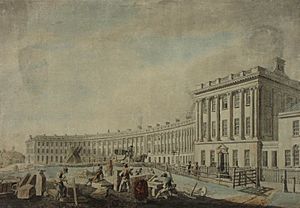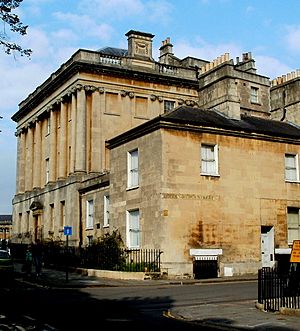No. 1 Royal Crescent facts for kids
Quick facts for kids No. 1 Royal Crescent |
|
|---|---|
 |
|
| Type | Townhouse |
| Location | Royal Crescent, Bath |
| Built | 1767–1774 |
| Original use | Private residence |
| Restored | 2012–2013 |
| Current use | Historic house museum |
| Architect | John Wood, the Younger |
| Architectural style(s) | Georgian, Palladian |
| Owner | Bath Preservation Trust |
|
Listed Building – Grade I
|
|
| Official name: No. 1, Royal Crescent | |
| Designated | 12 June 1950 |
| Part of | Nos. 1-30, Royal Crescent |
| Reference no. | 1394736 |
|
Listed Building – Grade II
|
|
| Official name: 1A, Royal Crescent | |
| Designated | 5 August 1975 |
| Reference no. | 1394740 |
| Lua error in Module:Location_map at line 420: attempt to index field 'wikibase' (a nil value). | |
No. 1 Royal Crescent is a very important building in Bath, Somerset, England. It's the first house at the eastern end of the famous Royal Crescent. Today, it's home to the Bath Preservation Trust, a group that helps protect historic places. It's also a museum where you can see how people lived in the Georgian era (the 1700s).
The house was recently updated between 2012 and 2013. This project brought No. 1 back together with its original service wing, No. 1A. These two parts had been separated for many years.
Contents
History of No. 1 Royal Crescent
No. 1 Royal Crescent is a key part of the Royal Crescent. This famous row of houses was built by John Wood, the Younger between 1767 and 1774. It is one of the most amazing buildings from the 1700s. No. 1 is considered one of the most important buildings in the UK. It shows the best of Palladian architecture in Bath.
The house has a balanced front with five windows. It also has a special door frame in the Doric order style. The first person to rent the house was Thomas Brock in 1769. Later, in 1776, Prince Frederick, Duke of York and Albany lived there. The first person to live there permanently was Henry Sandford. He was a retired politician from Ireland. He lived in the house with his family from 1777 until he passed away in 1796.
No. 1 Royal Crescent is now a museum. Most of its rooms are set up to show what life was like in a grand house in Bath during the 1700s. The Bath Preservation Trust owns and takes care of the museum. They use money from members and donations to show how wealthy people lived in such a house.
In 1967, Major Bernard Cayzer bought No. 1. He was part of the family that owned the Clan shipping line. He gave the house to the Bath Preservation Trust. He also gave money to help restore and furnish it. From 2012 to 2013, the Trust worked to connect No. 1 with its original servants' wing, No. 1A. This part had been a separate home since the 1960s.
Bringing the House Back Together
In the 1900s, No. 1 Royal Crescent was split into two separate properties. The original service wing, on the east side, was sold off as No. 1A Royal Crescent. In 2006, the Brownsword Charitable Foundation bought No. 1A. Their goal was to reunite it with No. 1. This would allow the Bath Preservation Trust to make the house as close to its original design as possible. It also meant they could make the museum better for visitors and learning. They could add new exhibition spaces too.
With a lot of help from the Heritage Lottery Fund and other generous donations, the big restoration work began in January 2012. On the outside, the windows on the Upper Church Street side were fixed. They now look like they did when people like Jane Austen walked by in the late 1700s and early 1800s. The door to No. 1A was also reopened in its original spot.
Inside, the number of rooms decorated in the Georgian style grew from five to ten. The original kitchens were found and restored. A learning center was made for school groups. An exhibition gallery was opened, and a new shop was added. A lift was also put in to help people with disabilities. The museum reopened to the public in June 2013. Mary Berry helped celebrate by cutting the ribbon.
During the project, old journals belonging to Henry Sandford were found in an Irish library. He was the first long-term resident of the house. These journals helped the museum show his life and interests. This helps visitors feel like they are truly experiencing life in the 1700s. You can see a fancy meal on the dining table. The bedrooms are ready for their occupants. The drawing room sparkles with mirrors. The kitchens look like servants are busy preparing food.
The museum also has portraits of famous people. These include Alexander Pope, Ralph Allen, and Thomas Betterton.
Bath Preservation Trust Offices
The Bath Preservation Trust has its offices on the upper floors of No. 1 Royal Crescent.
No. 1 Royal Crescent in Film and TV
No. 1 Royal Crescent has been used as a filming location many times. It has appeared in movies and TV shows.
- 1964: The BBC TV series The Count of Monte Cristo
- 1974: The movie Barry Lyndon was filmed outside No. 1.
- 1976: The movie Joseph Andrews was filmed inside and outside No. 1.
- 1987: The BBC TV series of Jane Austen's Northanger Abbey was filmed inside and outside No. 1.
- 2000: The movie Evolution, Part 1: Darwin's Dangerous Idea was filmed inside and outside No. 1.
- 2014: BBC TV's Countryfile Christmas Special included a scene filmed inside No. 1.
- 2016: An episode of Michael Portillo's Great British Railway Journeys was filmed in the house. It was shown on BBC TV on January 20, 2016.
- 2019: The Netflix drama Bridgerton featured No. 1 as the house of the Featherington family.



